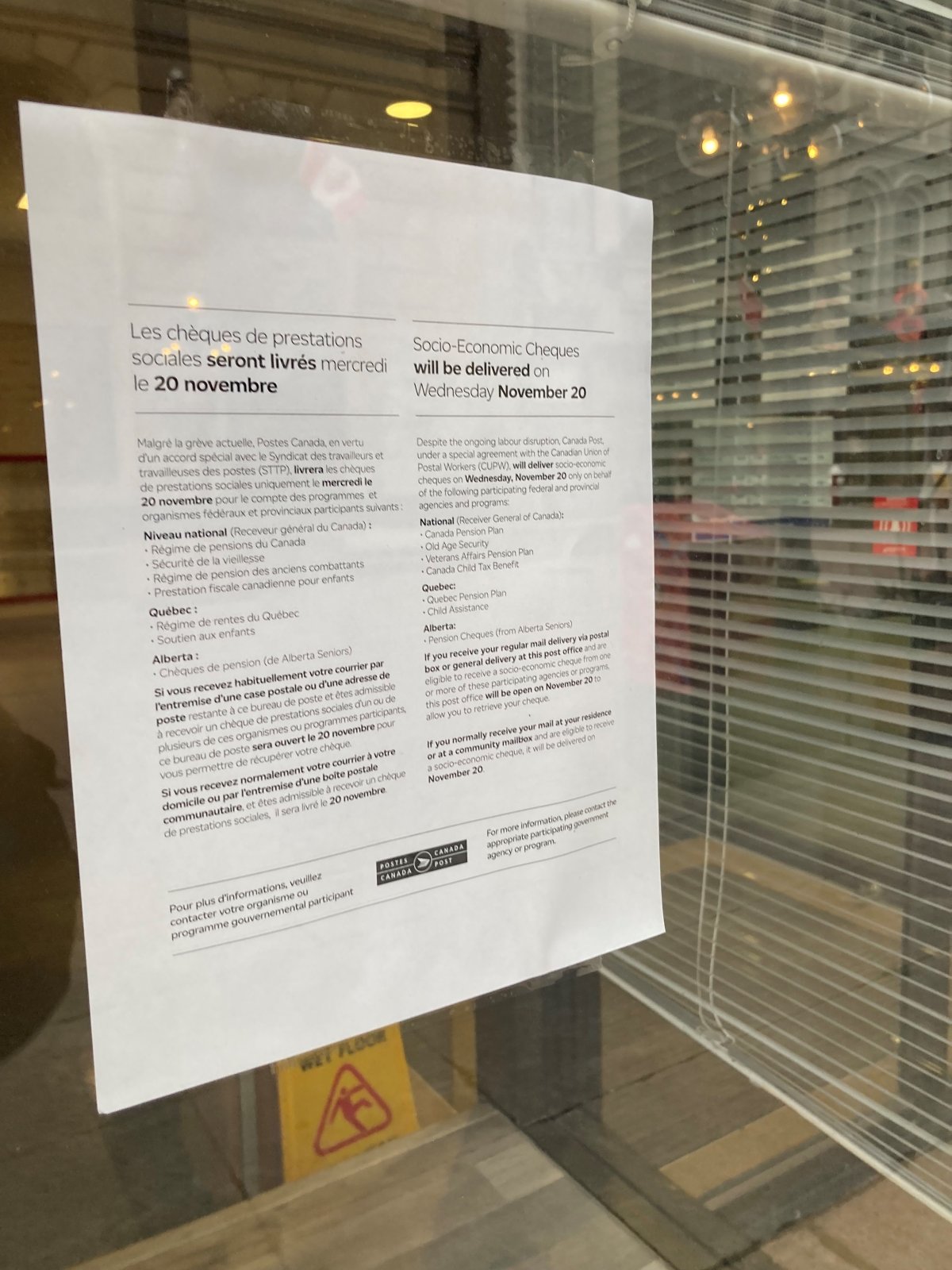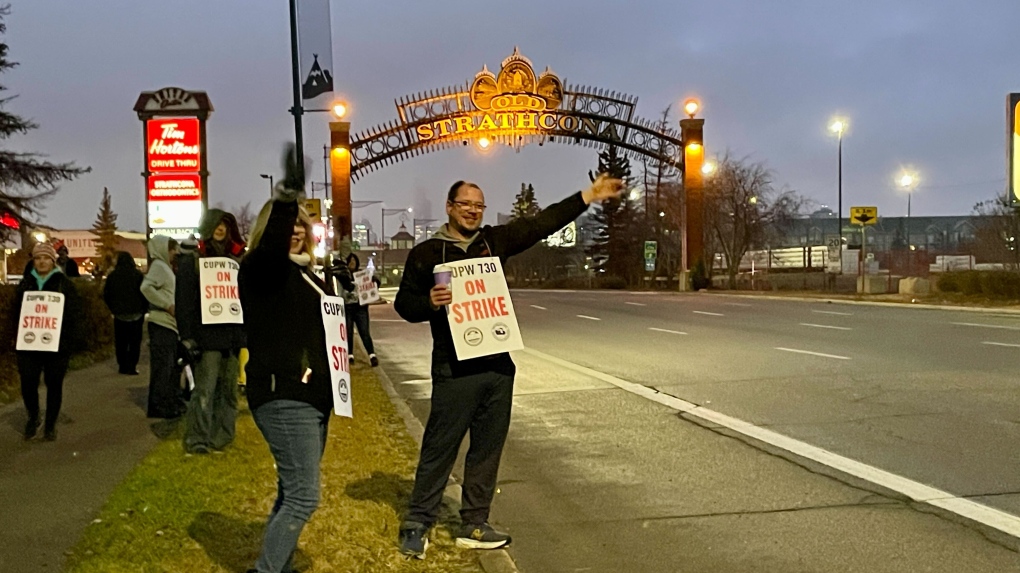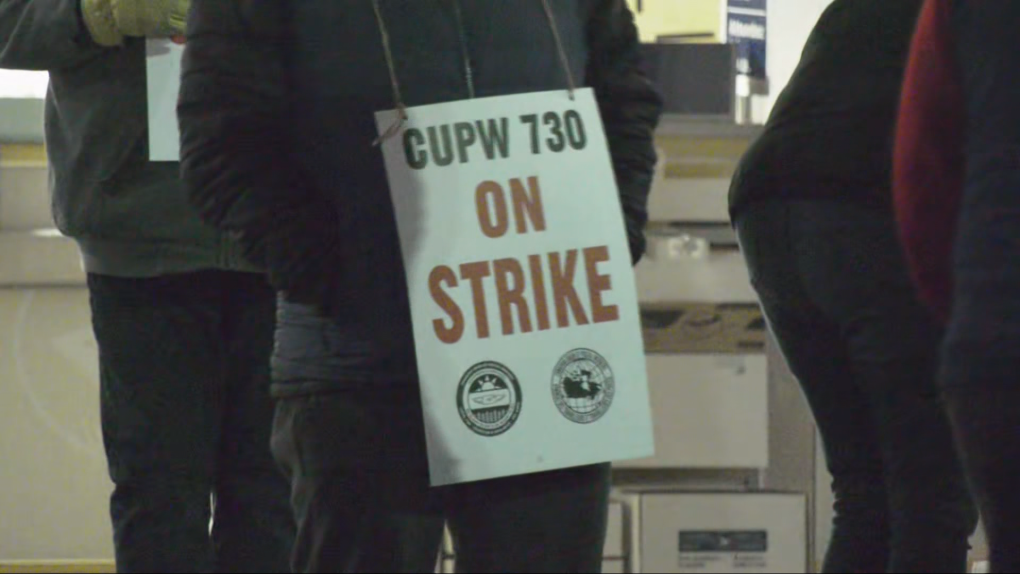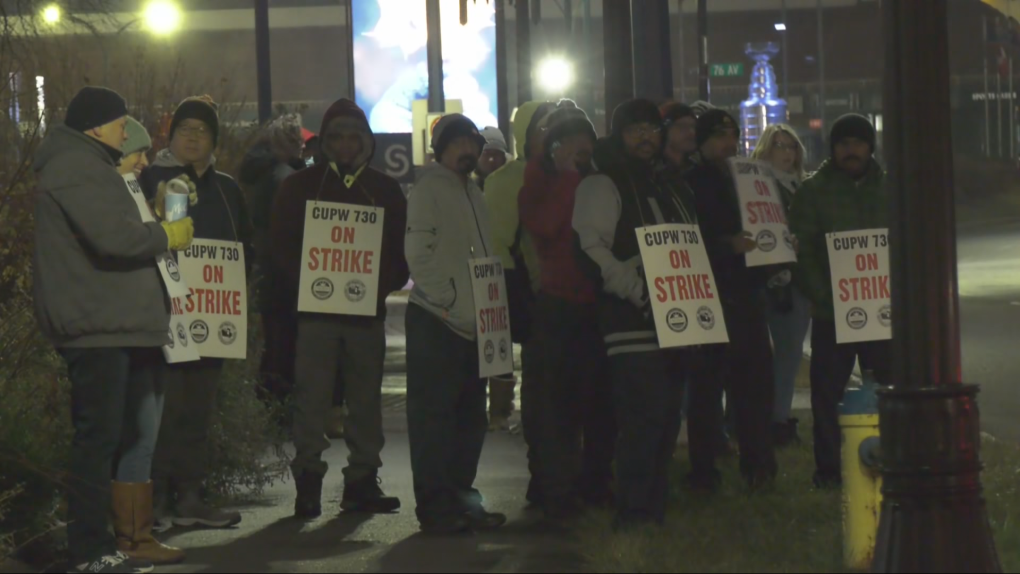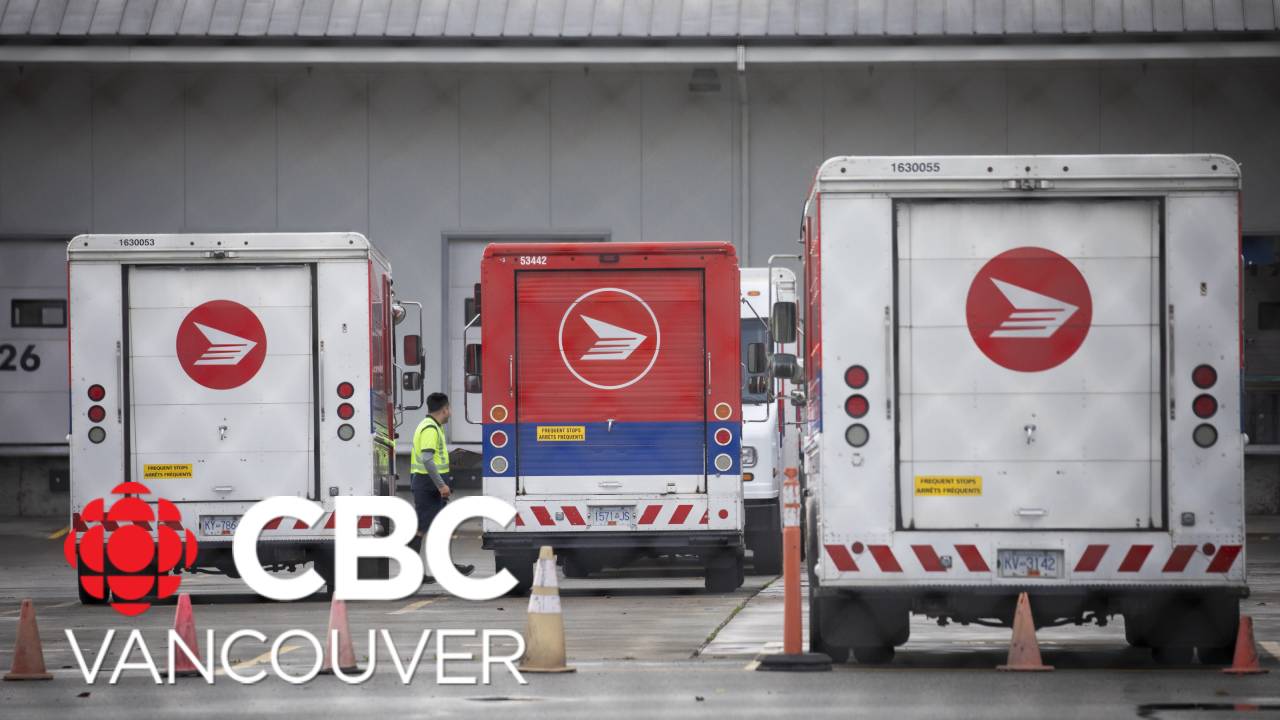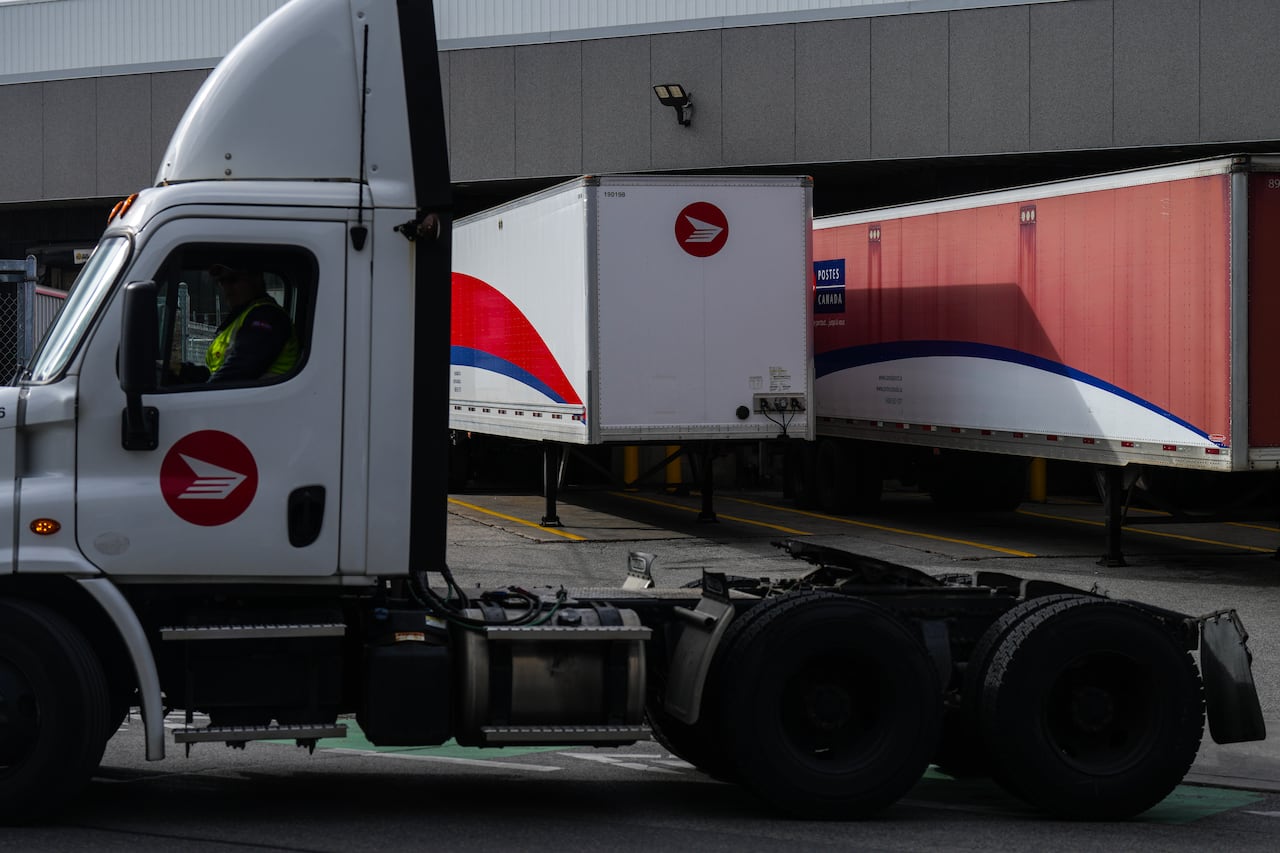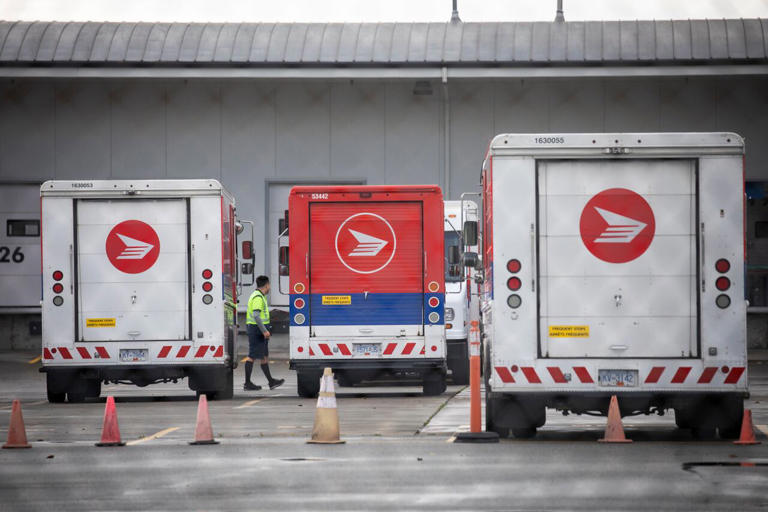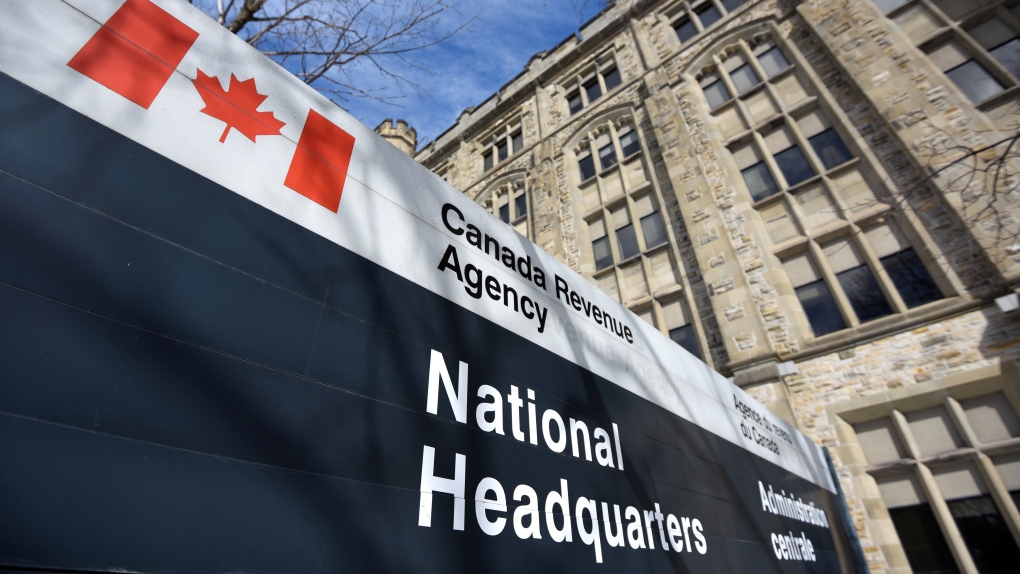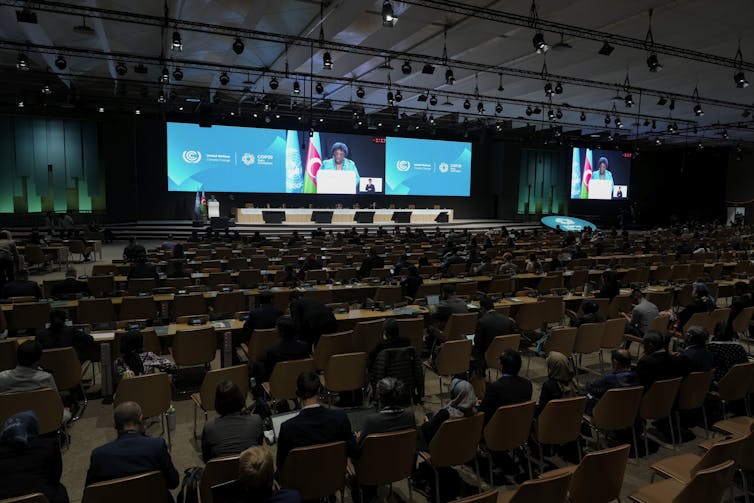Braid: Stephen Harper at AIMCo and UCP's pension drive go hand-in-hand
Smith keeps laying down sovereignty building blocks at a furious pace, playing on support still fuelled by public anger at Trudeau
Author of the article:
Ted Morton, a former Alberta minister who also signed that letter, says the best Harper could do was “leave Alberta alone.” And he did; for nine years the federal government was friendly to successive provincial PC regimes.

Province eyes former PM Stephen Harper to be next AIMCo chairman

AIMCo upheaval resurrects questions over future of proposed Alberta pension plan
Morton says hopefully that if Harper now leads AIMCo toward a provincial pension, he would “come full circle.”


'Needs to be resolved': Canada Post workers strike in Calgary, across Canada
Despite widespread fear of the concept, the pension plan probably could be sold to the public, eventually.
Before a referendum, the big incentive would be a promise of lifetime monthly payments higher than the CPP.
The Firewall Letter only referred to “the same benefits at lower cost.” The payoff would have to be much bigger than that.
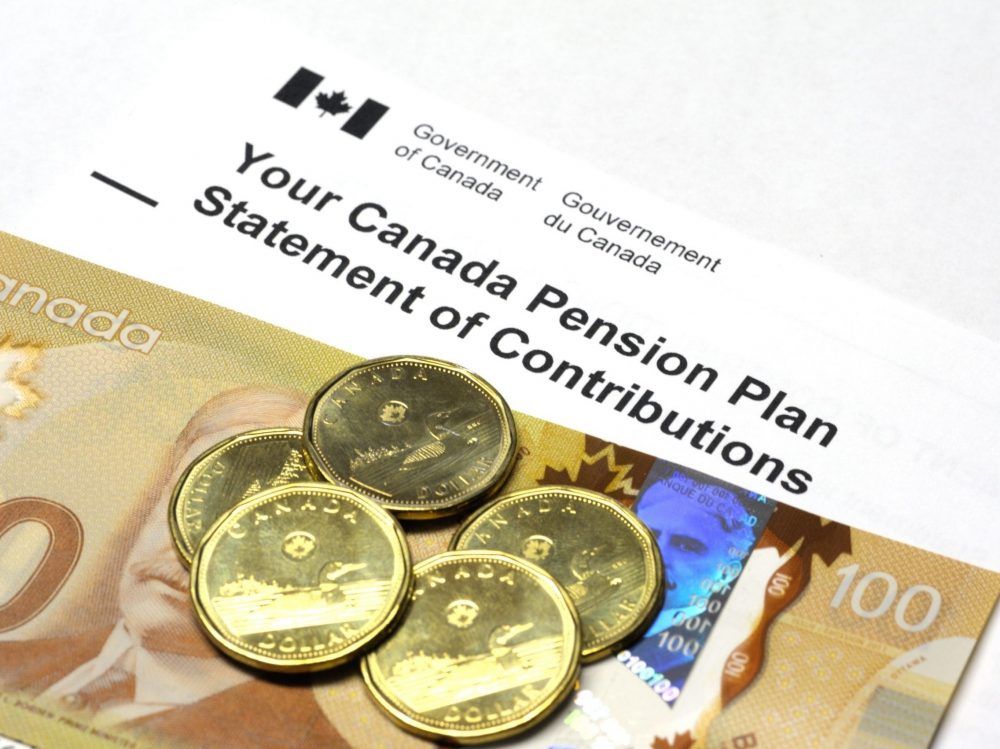
The government is also pushing hard for other key sovereignty measures, including a provincial police force. The dream of a provincial tax collection agency is still active, although quiet for now.
Soon we’ll see a major provincial claim to new powers, stemming from the federal emissions cap.
But Smith and the UCP are working furiously because they have a problem. His name is Pierre Poilievre.
If the Conservative leader becomes prime minister, much of the local fury at Liberal Ottawa will disappear, along with the hunger for sovereignty measures.
Poilievre will be an ally on many issues, especially in energy.
But like Harper before him, Poilievre would never agree to gutting the CPP. He could hardly endorse the Free Alberta Strategy, which raises the prospect of separation as a last resort.

Smith keeps laying down sovereignty building blocks at a furious pace, playing on support still fuelled by public anger at Trudeau
Author of the article:
By Don Braid • Calgary Herald
Published Nov 14, 2024
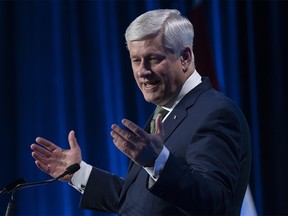
Published Nov 14, 2024

Former prime minister Stephen Harper delivers the keynote address at a conference on Wednesday, March 22, 2023 in Ottawa. Adrian Wyld/The Canadian Press
Within days, former prime minister Stephen Harper will almost certainly be the new chair of Alberta Investment Management Corp. (AIMCo).
Some people wonder if this has anything to do with the UCP drive for a provincial pension plan.
Ya think?
Five years before he became prime minister, Harper signed the famous Firewall Letter sent to then-premier Ralph Klein on Jan. 24, 2001.
The letter urged the Alberta government to “Withdraw from the Canada Pension Plan to create an Alberta Pension Plan offering the same benefits at lower cost, while giving Alberta control over the investment fund . . . The legislation setting up the Canada Pension Plan permits a province to run its own plan, as Quebec has done from the beginning.
Within days, former prime minister Stephen Harper will almost certainly be the new chair of Alberta Investment Management Corp. (AIMCo).
Some people wonder if this has anything to do with the UCP drive for a provincial pension plan.
Ya think?
Five years before he became prime minister, Harper signed the famous Firewall Letter sent to then-premier Ralph Klein on Jan. 24, 2001.
The letter urged the Alberta government to “Withdraw from the Canada Pension Plan to create an Alberta Pension Plan offering the same benefits at lower cost, while giving Alberta control over the investment fund . . . The legislation setting up the Canada Pension Plan permits a province to run its own plan, as Quebec has done from the beginning.
“If Quebec can do it, why not Alberta?”
Premier Danielle Smith obviously wants AIMCo to manage this new pension fund, just as the Caisse de Depot handles Quebec’s stand-alone pension.
To that end, AIMCo has to be a lot more visible — and successful — than it was when she recently fired the entire board.
The Caisse is an investment whale with $434.4 billion under management. AIMCo has a relatively paltry $168 billion.
The UCP wants to top that up with a $334-billion divorce settlement from the CPP — 53 per cent of the national fund.
This is politically impossible, as Harper himself showed when he became PM and did nothing to advance the Firewall pension push.
Premier Danielle Smith obviously wants AIMCo to manage this new pension fund, just as the Caisse de Depot handles Quebec’s stand-alone pension.
To that end, AIMCo has to be a lot more visible — and successful — than it was when she recently fired the entire board.
The Caisse is an investment whale with $434.4 billion under management. AIMCo has a relatively paltry $168 billion.
The UCP wants to top that up with a $334-billion divorce settlement from the CPP — 53 per cent of the national fund.
This is politically impossible, as Harper himself showed when he became PM and did nothing to advance the Firewall pension push.
Ted Morton, a former Alberta minister who also signed that letter, says the best Harper could do was “leave Alberta alone.” And he did; for nine years the federal government was friendly to successive provincial PC regimes.

Province eyes former PM Stephen Harper to be next AIMCo chairman

AIMCo upheaval resurrects questions over future of proposed Alberta pension plan
Morton says hopefully that if Harper now leads AIMCo toward a provincial pension, he would “come full circle.”

Ted Morton speaks at the Value of Alberta conference in Calgary on Jan. 18, 2020. Darren Makowichuk/Postmedia
Article content
Harper would certainly bring stature and profile to AIMCo, at least among conservatives. He was by far the most successful Alberta prime minister (the others being Joe Clark and, far back in the 1930s, R. B. Bennett).
The pension plan is not popular with most Albertans. It’s a scary move with direct impact on everybody’s bank account, sooner or later.
Herald columnist Chris Nelson argues with his usual verve that Smith and the UCP should drop the plan entirely, lest it destroy them
That isn’t about to happen. Smith’s chief of staff, Rob Anderson, is an author of the Free Alberta Strategy, which the premier rode into office. It argues fiercely for the Alberta pension.
Varcoe: Smith heading to Trump's inauguration, but 'not worried' about U.S. tariffs on Canadian energy
Article content
Harper would certainly bring stature and profile to AIMCo, at least among conservatives. He was by far the most successful Alberta prime minister (the others being Joe Clark and, far back in the 1930s, R. B. Bennett).
The pension plan is not popular with most Albertans. It’s a scary move with direct impact on everybody’s bank account, sooner or later.
Herald columnist Chris Nelson argues with his usual verve that Smith and the UCP should drop the plan entirely, lest it destroy them
That isn’t about to happen. Smith’s chief of staff, Rob Anderson, is an author of the Free Alberta Strategy, which the premier rode into office. It argues fiercely for the Alberta pension.
Varcoe: Smith heading to Trump's inauguration, but 'not worried' about U.S. tariffs on Canadian energy

'Needs to be resolved': Canada Post workers strike in Calgary, across Canada

Despite widespread fear of the concept, the pension plan probably could be sold to the public, eventually.
Before a referendum, the big incentive would be a promise of lifetime monthly payments higher than the CPP.
The Firewall Letter only referred to “the same benefits at lower cost.” The payoff would have to be much bigger than that.

The government is also pushing hard for other key sovereignty measures, including a provincial police force. The dream of a provincial tax collection agency is still active, although quiet for now.
Soon we’ll see a major provincial claim to new powers, stemming from the federal emissions cap.
But Smith and the UCP are working furiously because they have a problem. His name is Pierre Poilievre.
If the Conservative leader becomes prime minister, much of the local fury at Liberal Ottawa will disappear, along with the hunger for sovereignty measures.
Poilievre will be an ally on many issues, especially in energy.
But like Harper before him, Poilievre would never agree to gutting the CPP. He could hardly endorse the Free Alberta Strategy, which raises the prospect of separation as a last resort.

Conservative L Leader Pierre Poilievre speaks in the House of Commons on Tuesday, Sept. 24, 2024. Adrian Wyld The Canadian Press
The thinkers behind this movement have always said no federal government will ever redress what Morton, in his new book titled Strong and Free, calls the “deeper structural vulnerability to predatory federal policies.”
To them it doesn’t matter what party runs the country. The trouble is baked in. The UCP want Poilievre to get that message.
And so, Smith keeps laying down sovereignty building blocks at a furious pace, playing on support still fuelled by public anger at Trudeau.
Re-enter Stephen Harper, stage right.
Don Braid’s column appears regularly in the Herald
X: @DonBraid
The thinkers behind this movement have always said no federal government will ever redress what Morton, in his new book titled Strong and Free, calls the “deeper structural vulnerability to predatory federal policies.”
To them it doesn’t matter what party runs the country. The trouble is baked in. The UCP want Poilievre to get that message.
And so, Smith keeps laying down sovereignty building blocks at a furious pace, playing on support still fuelled by public anger at Trudeau.
Re-enter Stephen Harper, stage right.
Don Braid’s column appears regularly in the Herald
X: @DonBraid
Public ambush sends alert to $169 billion Alberta pension: Government’s in charge
By Layan Odeh, Paula Sambo and Dawn Lim


‘First kick’
Alberta produces the vast majority of Canada’s crude oil — close to 4 million barrels a day — and its economy relies on fossil-fuel revenues for creating jobs and boosting growth. In fact, government royalties from oil and gas form a part of the pool of money Aimco manages.
The province is led by Premier Danielle Smith, a conservative and outspoken booster of the oil and gas sector who frequently fights with Prime Minister Justin Trudeau’s left-leaning government in Ottawa. Recently, Smith said she was “pissed” about federal draft rules to cap oil and gas emissions and vowed to challenge them.
Siddall didn’t embody Alberta’s conservatism.
A longtime public servant who has Parkinson’s disease, he increased the focus on human resources at Aimco and boosted diversity and inclusion initiatives — including hiring a chief people officer.
On Instagram, he posted photos from a COP climate conference in Egypt and reflected on Canada’s treatment of indigenous people.
While he rejected fossil-fuel divestment — a political non-starter in Alberta — he also pitched decarbonization as an attractive investment strategy.
In February, Aimco said it was creating a C$1 billion fund dedicated to the energy transition, including “low-carbon renewable energy production,” to be led by then-CIO Puffer.
Some clients complained to the government that the pension fund manager was steering away from Aimco’s principles. Others backed its direction.
Ultimately, Horner sided with the first group. The government has for months been mulling giving the chairman’s role to Harper, according to people familiar with the matter. He’s a longtime politician who led the Conservative Party of Canada to three straight election victories — and he’s deeply trusted by conservatives in Alberta.
The finance minister waited for an opening. Then came last week’s purge at the Westin hotel. More changes are certain, potentially destabilizing Aimco further.
“You’re kicking at the foundation, and the concern is that when you kick at the foundations enough, at some point they’re all gonna fall down,” said Dyck, the pension expert, speaking about Canadian pension funds in general and their history of political non-interference. “It’s just, this is the first kick.”
By Layan Odeh, Paula Sambo and Dawn Lim
November 15, 2024 a
(Bloomberg) -- It was supposed to be a bonding experience.
Evan Siddall, then-chief executive officer of Alberta Investment Management Corp., gathered about 170 senior staff at The Westin Edmonton for a meeting and an exercise on “how to lead from a place of joy” taught by The Moth, a nonprofit dedicated to the art of storytelling.
Things quickly turned joyless.
Nate Horner, Alberta’s finance minister, showed up to tell Siddall and three other executives they no longer had jobs. The four left the building after their phones and laptops were confiscated. Horner then broke the news to the remaining Aimco employees. He also dismissed the entire board.
The public purge sent a clear message: The government of Alberta is the boss, and it’s taking back control.
Horner has temporarily become the fund manager’s chairman and sole director, and the conservative regime that rules the Canadian province plans to overhaul the firm and cut costs.
“To restore confidence in the agency, Alberta’s government has decided to reset the investment corporation’s focus with a new CEO and board,” the government of Alberta said in a statement.
Canada’s biggest pension funds — dubbed the Maple Eight – have long been the envy of peers. They’re admired as among the world’s most sophisticated money managers, known for independence from politics, managing most of their assets internally, hiring world-class talent and paying top executives millions of dollars.
Aimco has invested with elite alternative asset shops such as Blackstone Inc. and KKR & Co.
Now Aimco is controlled by a populist government, which has been considering putting an ex-politician, former Prime Minister Stephen Harper, in charge of the board. The Edmonton-based firm manages about C$169 billion ($120 billion) of public pensions plans and government funds, all of which have a stake in who’s running the show.
“No well-run firm replaces all of its executive team and whole board at once,” pension expert Alexander Dyck, a finance professor at the University of Toronto’s Rotman School of Management, said in an interview. “That’s a recipe for disaster.”
Some staffers and government officials didn’t view the ousters as politically motivated, but rather as a responsible move after complaints about churn and cost under Siddall. Others see it as an attack on the Canadian model of independence that has helped the pension funds attract top talent.
Either way, the intervention has stoked panic among staff over their jobs and pay. In recent years, Aimco has lured people from firms such as Carlyle Group Inc., Royal Bank of Canada and Barclays Plc. Employees have already told acquaintances they want new jobs, anticipating the province will begin treating the pension manager like a state agency and slash their pay.
There are few leaders left at the firm who can reassure them.
Aimco has been without a permanent chairman since the end of last year, and its audit committee chair left in April. Even before last week’s deposition, Aimco experienced senior staff turnover under Siddall.
A chief legal officer and a chief corporate officer left during his tenure. Four different people held the title of chief investment officer in a little more than three years. The last, Marlene Puffer, departed in September as the Alberta government intensified pressure on the company.
To politicians, Siddall seemed disconnected from Alberta’s fiscally conservative culture, neglecting complaints about rising costs.
He grew corporate, non-investment functions and made splashy expenditures along the way, including renting an office in high-end tower One Vanderbilt in New York despite the reservations of some staff.
While an internal study showed the fund’s costs were near the bottom of its peer group in 2022, the appearance that it was spending lavishly posed a problem for the provincial government.
(Bloomberg) -- It was supposed to be a bonding experience.
Evan Siddall, then-chief executive officer of Alberta Investment Management Corp., gathered about 170 senior staff at The Westin Edmonton for a meeting and an exercise on “how to lead from a place of joy” taught by The Moth, a nonprofit dedicated to the art of storytelling.
Things quickly turned joyless.
Nate Horner, Alberta’s finance minister, showed up to tell Siddall and three other executives they no longer had jobs. The four left the building after their phones and laptops were confiscated. Horner then broke the news to the remaining Aimco employees. He also dismissed the entire board.
The public purge sent a clear message: The government of Alberta is the boss, and it’s taking back control.
Horner has temporarily become the fund manager’s chairman and sole director, and the conservative regime that rules the Canadian province plans to overhaul the firm and cut costs.
“To restore confidence in the agency, Alberta’s government has decided to reset the investment corporation’s focus with a new CEO and board,” the government of Alberta said in a statement.
Canada’s biggest pension funds — dubbed the Maple Eight – have long been the envy of peers. They’re admired as among the world’s most sophisticated money managers, known for independence from politics, managing most of their assets internally, hiring world-class talent and paying top executives millions of dollars.
Aimco has invested with elite alternative asset shops such as Blackstone Inc. and KKR & Co.
Now Aimco is controlled by a populist government, which has been considering putting an ex-politician, former Prime Minister Stephen Harper, in charge of the board. The Edmonton-based firm manages about C$169 billion ($120 billion) of public pensions plans and government funds, all of which have a stake in who’s running the show.
“No well-run firm replaces all of its executive team and whole board at once,” pension expert Alexander Dyck, a finance professor at the University of Toronto’s Rotman School of Management, said in an interview. “That’s a recipe for disaster.”
Some staffers and government officials didn’t view the ousters as politically motivated, but rather as a responsible move after complaints about churn and cost under Siddall. Others see it as an attack on the Canadian model of independence that has helped the pension funds attract top talent.
Either way, the intervention has stoked panic among staff over their jobs and pay. In recent years, Aimco has lured people from firms such as Carlyle Group Inc., Royal Bank of Canada and Barclays Plc. Employees have already told acquaintances they want new jobs, anticipating the province will begin treating the pension manager like a state agency and slash their pay.
There are few leaders left at the firm who can reassure them.
Aimco has been without a permanent chairman since the end of last year, and its audit committee chair left in April. Even before last week’s deposition, Aimco experienced senior staff turnover under Siddall.
A chief legal officer and a chief corporate officer left during his tenure. Four different people held the title of chief investment officer in a little more than three years. The last, Marlene Puffer, departed in September as the Alberta government intensified pressure on the company.
To politicians, Siddall seemed disconnected from Alberta’s fiscally conservative culture, neglecting complaints about rising costs.
He grew corporate, non-investment functions and made splashy expenditures along the way, including renting an office in high-end tower One Vanderbilt in New York despite the reservations of some staff.
While an internal study showed the fund’s costs were near the bottom of its peer group in 2022, the appearance that it was spending lavishly posed a problem for the provincial government.

(Aimco annual reports)
And it wasn’t the only issue. Siddall’s positive stance on green investing and his globe-trotting irked officials in oil-rich Alberta, who preferred their pension manager to keep a lower profile.
Along with Siddall, the other senior executives dismissed by Horner included the chief legal officer, the chief of staff and the chief people, culture and engagement officer. None of those executives worked on investments directly.
This story is based on conversations with multiple people familiar with Aimco and Alberta’s government. The people asked not to be identified to discuss confidential matters; some cited concerns over retaliation. A spokesperson for Aimco declined to comment.
New offices
Siddall, the former head of Canada’s federal housing agency, became CEO of Aimco in July 2021 after it lost C$2.1 billion on a bet against market volatility that blew up when the pandemic hit.
Fast-talking and blunt, Siddall aimed to elevate Aimco’s profile on Wall Street. Hired with a mandate to revamp the operation, he created new roles such as chief technology officer. While most of staff were in Edmonton, he wanted to attract people beyond Canada, too.
Early this year, Aimco opened the office in New York in One Vanderbilt. The real estate team had suggested at least five cheaper locations for the New York office, but Siddall thought it was important to have an office that attracted staff to work, according to people familiar with the matter.
Several months earlier, Siddall had opened an outpost in Singapore to focus on investments in Asia-Pacific. Aimco’s investments in Asia stood at around 3% of total assets as of last year.
He hired GIC Pte’s Kevin Bong to lead the efforts there. Aimco, which also opened an office in Calgary in 2022, has around 600 people working from seven offices, while giving them the flexibility to work remotely. In London, Siddall caught people’s attention with a renovation to accommodate more staff.
The global expansion suggested to some within the government that the pension fund was shifting priorities away from Edmonton, where its presence has supported the city’s economy. Aimco invests more than 40% of its assets in Canada, with a large chunk of that deployed in its home province.
Alberta Teachers’ Retirement Fund, one of Aimco’s clients, said in the past it has raised issues regarding costs with both the government and the fund. Aimco management has always been transparent about expenses, according to people close to the firm.
Aimco’s clients had asked for an almost doubling of allocations to private assets, driving more costs, according to a letter from former board Vice Chair Ken Kroner to government officials.
“Aimco hired the talent necessary to support this client-led growth, and this should not be misinterpreted as evidence of costs being out of control,” he wrote, adding that fees to outside managers grew at a slower pace than assets.
But as IT and human resources budgets added up, new expenses became a flashpoint.
Staff costs ballooned by 71%, and headcount grew by 29% from 2019 to 2023, according to a statement from Horner’s office. Third-party management fees also increased by 96% during the period.
And it wasn’t the only issue. Siddall’s positive stance on green investing and his globe-trotting irked officials in oil-rich Alberta, who preferred their pension manager to keep a lower profile.
Along with Siddall, the other senior executives dismissed by Horner included the chief legal officer, the chief of staff and the chief people, culture and engagement officer. None of those executives worked on investments directly.
This story is based on conversations with multiple people familiar with Aimco and Alberta’s government. The people asked not to be identified to discuss confidential matters; some cited concerns over retaliation. A spokesperson for Aimco declined to comment.
New offices
Siddall, the former head of Canada’s federal housing agency, became CEO of Aimco in July 2021 after it lost C$2.1 billion on a bet against market volatility that blew up when the pandemic hit.
Fast-talking and blunt, Siddall aimed to elevate Aimco’s profile on Wall Street. Hired with a mandate to revamp the operation, he created new roles such as chief technology officer. While most of staff were in Edmonton, he wanted to attract people beyond Canada, too.
Early this year, Aimco opened the office in New York in One Vanderbilt. The real estate team had suggested at least five cheaper locations for the New York office, but Siddall thought it was important to have an office that attracted staff to work, according to people familiar with the matter.
Several months earlier, Siddall had opened an outpost in Singapore to focus on investments in Asia-Pacific. Aimco’s investments in Asia stood at around 3% of total assets as of last year.
He hired GIC Pte’s Kevin Bong to lead the efforts there. Aimco, which also opened an office in Calgary in 2022, has around 600 people working from seven offices, while giving them the flexibility to work remotely. In London, Siddall caught people’s attention with a renovation to accommodate more staff.
The global expansion suggested to some within the government that the pension fund was shifting priorities away from Edmonton, where its presence has supported the city’s economy. Aimco invests more than 40% of its assets in Canada, with a large chunk of that deployed in its home province.
Alberta Teachers’ Retirement Fund, one of Aimco’s clients, said in the past it has raised issues regarding costs with both the government and the fund. Aimco management has always been transparent about expenses, according to people close to the firm.
Aimco’s clients had asked for an almost doubling of allocations to private assets, driving more costs, according to a letter from former board Vice Chair Ken Kroner to government officials.
“Aimco hired the talent necessary to support this client-led growth, and this should not be misinterpreted as evidence of costs being out of control,” he wrote, adding that fees to outside managers grew at a slower pace than assets.
But as IT and human resources budgets added up, new expenses became a flashpoint.
Staff costs ballooned by 71%, and headcount grew by 29% from 2019 to 2023, according to a statement from Horner’s office. Third-party management fees also increased by 96% during the period.

(Annual reports of the three fund)
Another source of friction: Aimco awarded a contract worth millions of dollars to BlackRock Inc. for its portfolio management software Aladdin.
Some insiders saw this as a necessary expense to replace an inferior risk-management tool. Others viewed it as an unnecessary contract that cost too much. BlackRock declined to comment.
Aimco spent C$276 million on salaries, wages and benefits in its last fiscal year, and awarded Siddall more than C$4.5 million in direct pay.
New York State Teachers’ Retirement System, a US fund that oversees a similar amount of money but relies more heavily on outside managers than Canadian funds, spent $59 million on salaries and benefits, according to its most recent annual report.
Aimco ultimately falls in the lowest third on cost relative to peers, according to a study by CEM Benchmarking for 2022, the latest such study available. Its costs were 23% lower than those of average peers.
As for returns, Aimco beat its benchmarks in two of the three years Siddall was in charge, and recent internal surveys showed employee morale substantially improving. That gave the board few reasons to question his investment judgment.
But for politicians in Alberta’s capital city, it wasn’t quite so simple.
Another source of friction: Aimco awarded a contract worth millions of dollars to BlackRock Inc. for its portfolio management software Aladdin.
Some insiders saw this as a necessary expense to replace an inferior risk-management tool. Others viewed it as an unnecessary contract that cost too much. BlackRock declined to comment.
Aimco spent C$276 million on salaries, wages and benefits in its last fiscal year, and awarded Siddall more than C$4.5 million in direct pay.
New York State Teachers’ Retirement System, a US fund that oversees a similar amount of money but relies more heavily on outside managers than Canadian funds, spent $59 million on salaries and benefits, according to its most recent annual report.
Aimco ultimately falls in the lowest third on cost relative to peers, according to a study by CEM Benchmarking for 2022, the latest such study available. Its costs were 23% lower than those of average peers.
As for returns, Aimco beat its benchmarks in two of the three years Siddall was in charge, and recent internal surveys showed employee morale substantially improving. That gave the board few reasons to question his investment judgment.
But for politicians in Alberta’s capital city, it wasn’t quite so simple.
‘First kick’
Alberta produces the vast majority of Canada’s crude oil — close to 4 million barrels a day — and its economy relies on fossil-fuel revenues for creating jobs and boosting growth. In fact, government royalties from oil and gas form a part of the pool of money Aimco manages.
The province is led by Premier Danielle Smith, a conservative and outspoken booster of the oil and gas sector who frequently fights with Prime Minister Justin Trudeau’s left-leaning government in Ottawa. Recently, Smith said she was “pissed” about federal draft rules to cap oil and gas emissions and vowed to challenge them.
Siddall didn’t embody Alberta’s conservatism.
A longtime public servant who has Parkinson’s disease, he increased the focus on human resources at Aimco and boosted diversity and inclusion initiatives — including hiring a chief people officer.
On Instagram, he posted photos from a COP climate conference in Egypt and reflected on Canada’s treatment of indigenous people.
While he rejected fossil-fuel divestment — a political non-starter in Alberta — he also pitched decarbonization as an attractive investment strategy.
In February, Aimco said it was creating a C$1 billion fund dedicated to the energy transition, including “low-carbon renewable energy production,” to be led by then-CIO Puffer.
Some clients complained to the government that the pension fund manager was steering away from Aimco’s principles. Others backed its direction.
Ultimately, Horner sided with the first group. The government has for months been mulling giving the chairman’s role to Harper, according to people familiar with the matter. He’s a longtime politician who led the Conservative Party of Canada to three straight election victories — and he’s deeply trusted by conservatives in Alberta.
The finance minister waited for an opening. Then came last week’s purge at the Westin hotel. More changes are certain, potentially destabilizing Aimco further.
“You’re kicking at the foundation, and the concern is that when you kick at the foundations enough, at some point they’re all gonna fall down,” said Dyck, the pension expert, speaking about Canadian pension funds in general and their history of political non-interference. “It’s just, this is the first kick.”
Fired AIMCo chair disputes Alberta’s narrative on costs in letter to Horner
AIMCo is a low-cost manager compared to similar funds and has 'solidly' exceeded benchmarks over the years, says Kenneth Kroner
The former interim chair of Alberta Investment Management Corp. has written a letter to the Alberta cabinet minister who fired him last week to dispute what he calls an “incorrect narrative” and “misinformation” about the performance of the asset manager and Crown corporation.
In a letter to Alberta Finance Minister Nate Horner that was viewed by the Financial Post, Kenneth Kroner disputes the data and a number of assertions used to justify the government’s “reset” at AIMCo, which saw the entire board of directors, including Kroner, as well as chief executive Evan Siddall, removed from their posts. The letter goes on to say that while the government is within its rights to replace the board, the faulty narrative that AIMCo’s costs are out of control will make things difficult for the next board and management team.
“Over the last week, there have been numerous public statements made about AIMCo’s performance and costs,” wrote Kroner, who was on the board of AIMCo for eight years and had been acting chair since the beginning of this year. “I have concerns that these are tarnishing AIMCo’s reputation, which will only make it harder for Albertans to have confidence in the public asset manager, and will create unnecessary barriers for AIMCo in its goal to deliver strong investment performance for Albertans.
Contrary to skyrocketing costs and poor performance, he said AIMCo is a low-cost manager compared to similar funds and has “solidly” exceeded benchmarks over the years.
“The data contradicts the very negative narrative that is out there,” Kroner wrote in the letter, which was also sent to the government’s bipartisan standing committee on the Alberta Heritage Savings Trust Fund, which is managed by AIMCo.
“The misinformation will make it unnecessarily difficult for the next management team to be effective,” it said.
In statements to media since the board and Siddall were let go en masse last Thursday, Horner has said he and his team had asked for changes at AIMCo and applied “constant” pressure on costs.
“We asked for change. Weren’t seeing it. Weren’t seeing it. We were seeing the opposite,” he told the Calgary Herald.
“It became evident things were not going to change even with constant pressure from me and the team.”
In a statement announcing the board purge, the government said that AIMCo’s third-party management fees increased by 96 per cent in the 2019 to 2023 period, the number of employees increased by 29 per cent and salary, wage and benefit costs increased by 71 per cent. The government said the cost increases had not come with a commensurate increase in returns.
In Kroner’s response, dated Wednesday, Nov. 13, he said the government’s measure of AIMCo’s total returns ignores the fact that clients, such as operators of pension funds for teachers, judges and police officers, direct how much of each asset class the pension management organization should invest in on their behalf
“AIMCo’s mandate is to outperform the benchmarks that clients given them,” Kroner wrote. “This is why I’ve consistently emphasized that AIMCo’s contribution can only be measured by returns versus their client-directed benchmarks, not total returns.”
He said AIMCo has consistently added value on this metric, the only one it can control. For example, the provincial government’s Heritage Fund has seen an annualized 10-year return that is half a percentage point above its benchmark after all costs through the end of June. Returns outperformed the benchmark in seven of those years, and, after all costs, added $1 billion to the Heritage Fund, according to the letter.
“This is not poor investment performance as the narrative states, but rather is a performance record that Albertans can be proud of,” wrote Kroner, who holds a PhD in economics from the University of California at San Diego and was a senior managing director at Blackrock and predecessor Barclays Global Investments for more than 20 years.
As for the government’s statements about AIMCo’s costs, he said they were indeed rising, but so were assets under management. Moreover, independent firm CEM Benchmarking pegged AIMCo’s costs at 23 per cent below what an average peer would incur to manage AIMCo’s client assets.
“That $258-million (based on 2022 figures) goes straight into Albertan’s pockets,” Kroner wrote. “AIMCo has always been, and remains, a cost-conscious, high value-for-money asset manager.”
The government figures that Kroner says “are being used to tarnish AIMCo’s reputation” include an assessment of third-party management fees. Third-party assets rose by two and half times in the 2019 to 2023 period, so fees naturally went up. “But these fees went up at a much slower pace than assets,” he wrote, “and the data shows that AIMCo’s average third-party management fees dropped by a third … over that window. This is evidence of effective cost management not undisciplined cost management.”
He said AIMCo’s headcount increases have also drawn much public discussion, but that the staffing reflects client request for a near doubling of the illiquid investments such as real estate, private equity and infrastructure in the period between 2019 and 2023. It was well known that this would require expanding investment and legal teams, strengthening risk controls, and building a global presence.
“AIMCo hired the talent necessary to support this client-led growth, and this should not be misinterpreted as evidence of costs being out of control,” Kroner wrote.
Horner stepped in as acting chair following the board and executive purge last week. Alberta’s deputy minister of executive council, Ray Gilmour, the province’s top bureaucrat, was named interim chief executive.
Since then, speculation has emerged that former prime minister Stephen Harper will become AIMCo’s next chair. Sources say his name has been in the mix for nearly a year, since shortly after Mark Wiseman, former CEO of Canada Pension Plan Investment Board, announced plans to step down as chair of the Alberta pension and investment manager.

Stephen Harper's name in mix as potential head of AIMCo

AIMCo's performance before last week's ‘shocking’ purge
Representatives for Harper have not responded a request for comment.
On the day the board was let go, Horner said he expected to have a new board in place within 30 da
AIMCo is a low-cost manager compared to similar funds and has 'solidly' exceeded benchmarks over the years, says Kenneth Kroner
Published Nov 14, 2024 •
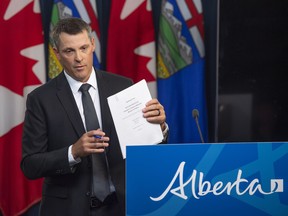

Alberta Finance Minister Nate Horner at the Alberta Legislature. Photo by Shaughn Butts/Postmedia files
The former interim chair of Alberta Investment Management Corp. has written a letter to the Alberta cabinet minister who fired him last week to dispute what he calls an “incorrect narrative” and “misinformation” about the performance of the asset manager and Crown corporation.
In a letter to Alberta Finance Minister Nate Horner that was viewed by the Financial Post, Kenneth Kroner disputes the data and a number of assertions used to justify the government’s “reset” at AIMCo, which saw the entire board of directors, including Kroner, as well as chief executive Evan Siddall, removed from their posts. The letter goes on to say that while the government is within its rights to replace the board, the faulty narrative that AIMCo’s costs are out of control will make things difficult for the next board and management team.
“Over the last week, there have been numerous public statements made about AIMCo’s performance and costs,” wrote Kroner, who was on the board of AIMCo for eight years and had been acting chair since the beginning of this year. “I have concerns that these are tarnishing AIMCo’s reputation, which will only make it harder for Albertans to have confidence in the public asset manager, and will create unnecessary barriers for AIMCo in its goal to deliver strong investment performance for Albertans.
Contrary to skyrocketing costs and poor performance, he said AIMCo is a low-cost manager compared to similar funds and has “solidly” exceeded benchmarks over the years.
“The data contradicts the very negative narrative that is out there,” Kroner wrote in the letter, which was also sent to the government’s bipartisan standing committee on the Alberta Heritage Savings Trust Fund, which is managed by AIMCo.
“The misinformation will make it unnecessarily difficult for the next management team to be effective,” it said.
In statements to media since the board and Siddall were let go en masse last Thursday, Horner has said he and his team had asked for changes at AIMCo and applied “constant” pressure on costs.
“We asked for change. Weren’t seeing it. Weren’t seeing it. We were seeing the opposite,” he told the Calgary Herald.
“It became evident things were not going to change even with constant pressure from me and the team.”
In a statement announcing the board purge, the government said that AIMCo’s third-party management fees increased by 96 per cent in the 2019 to 2023 period, the number of employees increased by 29 per cent and salary, wage and benefit costs increased by 71 per cent. The government said the cost increases had not come with a commensurate increase in returns.
In Kroner’s response, dated Wednesday, Nov. 13, he said the government’s measure of AIMCo’s total returns ignores the fact that clients, such as operators of pension funds for teachers, judges and police officers, direct how much of each asset class the pension management organization should invest in on their behalf
“AIMCo’s mandate is to outperform the benchmarks that clients given them,” Kroner wrote. “This is why I’ve consistently emphasized that AIMCo’s contribution can only be measured by returns versus their client-directed benchmarks, not total returns.”
He said AIMCo has consistently added value on this metric, the only one it can control. For example, the provincial government’s Heritage Fund has seen an annualized 10-year return that is half a percentage point above its benchmark after all costs through the end of June. Returns outperformed the benchmark in seven of those years, and, after all costs, added $1 billion to the Heritage Fund, according to the letter.
“This is not poor investment performance as the narrative states, but rather is a performance record that Albertans can be proud of,” wrote Kroner, who holds a PhD in economics from the University of California at San Diego and was a senior managing director at Blackrock and predecessor Barclays Global Investments for more than 20 years.
As for the government’s statements about AIMCo’s costs, he said they were indeed rising, but so were assets under management. Moreover, independent firm CEM Benchmarking pegged AIMCo’s costs at 23 per cent below what an average peer would incur to manage AIMCo’s client assets.
“That $258-million (based on 2022 figures) goes straight into Albertan’s pockets,” Kroner wrote. “AIMCo has always been, and remains, a cost-conscious, high value-for-money asset manager.”
The government figures that Kroner says “are being used to tarnish AIMCo’s reputation” include an assessment of third-party management fees. Third-party assets rose by two and half times in the 2019 to 2023 period, so fees naturally went up. “But these fees went up at a much slower pace than assets,” he wrote, “and the data shows that AIMCo’s average third-party management fees dropped by a third … over that window. This is evidence of effective cost management not undisciplined cost management.”
He said AIMCo’s headcount increases have also drawn much public discussion, but that the staffing reflects client request for a near doubling of the illiquid investments such as real estate, private equity and infrastructure in the period between 2019 and 2023. It was well known that this would require expanding investment and legal teams, strengthening risk controls, and building a global presence.
“AIMCo hired the talent necessary to support this client-led growth, and this should not be misinterpreted as evidence of costs being out of control,” Kroner wrote.
Horner stepped in as acting chair following the board and executive purge last week. Alberta’s deputy minister of executive council, Ray Gilmour, the province’s top bureaucrat, was named interim chief executive.
Since then, speculation has emerged that former prime minister Stephen Harper will become AIMCo’s next chair. Sources say his name has been in the mix for nearly a year, since shortly after Mark Wiseman, former CEO of Canada Pension Plan Investment Board, announced plans to step down as chair of the Alberta pension and investment manager.

Stephen Harper's name in mix as potential head of AIMCo

AIMCo's performance before last week's ‘shocking’ purge
Representatives for Harper have not responded a request for comment.
On the day the board was let go, Horner said he expected to have a new board in place within 30 da



